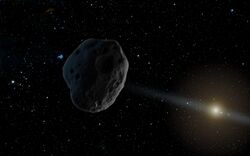Astronomy:2016 WF9
 Artist's rendition of 2016 WF9 | |
| Discovery[1] | |
|---|---|
| Discovered by | NEOWISE |
| Discovery site | Earth orbit |
| Discovery date | 27 November 2016 (discovery: first observed) |
| Designations | |
| 2016 WF9 | |
| Minor planet category | NEO · PHA · Apollo[2][3] |
| Orbital characteristics[2] | |
| Epoch 4 September 2017 (JD 2458000.5) | |
| Uncertainty parameter 4 | |
| Observation arc | (192 days) |
| |{{{apsis}}}|helion}} | 4.7614 AU |
| |{{{apsis}}}|helion}} | 0.9816 AU |
| 2.8715 AU | |
| Eccentricity | 0.6582 |
| Orbital period | 4.87 yr (1,777 days) |
| Mean anomaly | 43.511° |
| Mean motion | 0° 12m 9.36s / day |
| Inclination | 14.995° |
| Longitude of ascending node | 125.41° |
| 342.45° | |
| Earth MOID | 0.0156 AU (6.1 LD) |
| Jupiter MOID | 0.5211 AU |
| TJupiter | 2.893 (comet-like) |
| Physical characteristics | |
| Mean diameter | 0.5–1.0 km[4] |
| Geometric albedo | <0.05 (dark) |
| Absolute magnitude (H) | 20.2[2] |
2016 WF9 is a dark, sub-kilometer asteroid and suspected extinct comet, classified as near-Earth object and potentially hazardous asteroid of the Apollo group.[3]
Description
2016 WF9 is unusually dark for a near-Earth asteroid. It is possibly an extinct comet, but without the comet-like dust and gas cloud.[4] It was first observed on 27 November 2016 by NEOWISE, the asteroid-and-comet-hunting portion of the Wide-Field Infrared Survey Explorer (WISE) mission.[4] According to NEOWISE, this object could have cometary origins, which illustrates the blurry boundary between asteroids and comets. It is speculated that over time, this object has lost the majority of the volatiles on its surface.[5]
2016 WF9 is about 0.5–1.0 km (0.3–0.6 mi) across so is one of the larger potentially hazardous asteroid near-Earth object (also see list of largest PHAs).[4]
2017 approach
2016 WF9 passed Earth on 25 February 2017 at a distance of 0.3407 astronomical unit|AU (50,970,000 km; 31,670,000 mi) and is not considered a threat for the foreseeable future.[4][2] The 2017 approach did not bring it particularly close to Earth.[4] In December 1944 it passed about 0.19 AU (28,000,000 km; 18,000,000 mi) from Earth and in February 2149 it will pass about 0.06 AU (9,000,000 km; 5,600,000 mi) from Earth.[2]
Discovery
When 2016 WF9 was first announced and had a short insignificant 3 day observation arc, it was estimated to have a 7.6 year orbital period.[1] The preliminary orbit was also listed on the JPL Sentry Risk Table, but none of the virtual impact dates were before 2029.[6] As the observation arc became longer and the orbital parameters better constrained, it was removed from the Sentry Risk Table on 20 December 2016.[7] With a 111-day observation arc, it is now known that it has a 4.86 year orbital period and currently stays inside the orbit of Jupiter.[2]
A simulation of 2016 WF9's dynamics over a period of 100 million days (~274,000 years) found that it had roughly a 60% chance of originating from the outer Solar System as a long-period comet.[8]
References
- ↑ 1.0 1.1 "MPEC 2016-W125: 2016 WF9". IAU Minor Planet Center. 2016-11-30. http://www.minorplanetcenter.net/mpec/K16/K16WC5.html. Retrieved 2017-02-02. (K16W09F)
- ↑ 2.0 2.1 2.2 2.3 2.4 2.5 2.6 "JPL Small-Body Database Browser: (2016 WF9)". Jet Propulsion Laboratory. https://ssd.jpl.nasa.gov/sbdb.cgi?sstr=3764848;cad=1. Retrieved 8 February 2018.
- ↑ 3.0 3.1 "2016 WF9". Minor Planet Center. https://www.minorplanetcenter.net/db_search/show_object?object_id=2016+WF9. Retrieved 8 February 2018.
- ↑ 4.0 4.1 4.2 4.3 4.4 4.5 Agle, DC; Cantillo, Laurie; Brown, Dwayne (29 December 2016). "NASA's NEOWISE Mission Spies One Comet, Maybe Two". NASA. https://www.jpl.nasa.gov/news/news.php?feature=6712. Retrieved 29 December 2016.
- ↑ Williams, Matt (30 December 2016). "NASA'S NEOWISE Missions Spots New Comets". Universe Today. http://www.universetoday.com/132621/nasas-neowise-missions-spots-new-comets. Retrieved 31 December 2016.
- ↑ "Tracking News". hohmanntransfer. 2016-12-01. http://www.hohmanntransfer.com/mn/16/16335_1130.htm#risks. Retrieved 2017-02-02.
- ↑ "Date/Time Removed". NASA/JPL Near-Earth Object Program Office. http://neo.jpl.nasa.gov/risk/removed.html. Retrieved 2017-02-02.
- ↑ Odasso, Alessandro (9 January 2017). "2016 WF9 – a simulation based on Jan 5th orbital params". odassoastro.blogspot.it. http://odassoastro.blogspot.it/2017/01/2016-wf9-simulation-based-on-jan-5th.html. Retrieved 9 January 2017.
External links
- 2016 WF9 at the JPL Small-Body Database
 |




